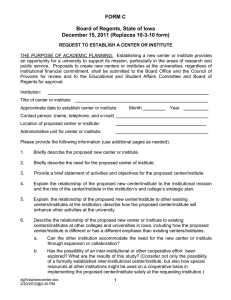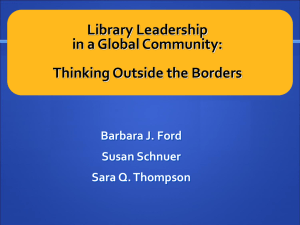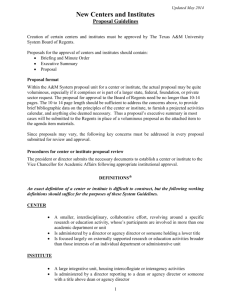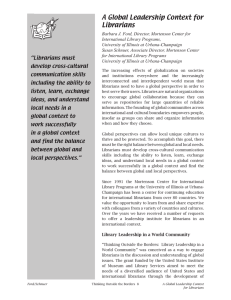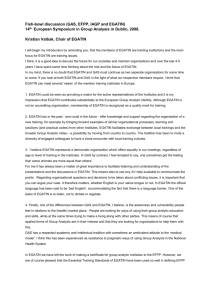How to Facilitate an International Institute
advertisement
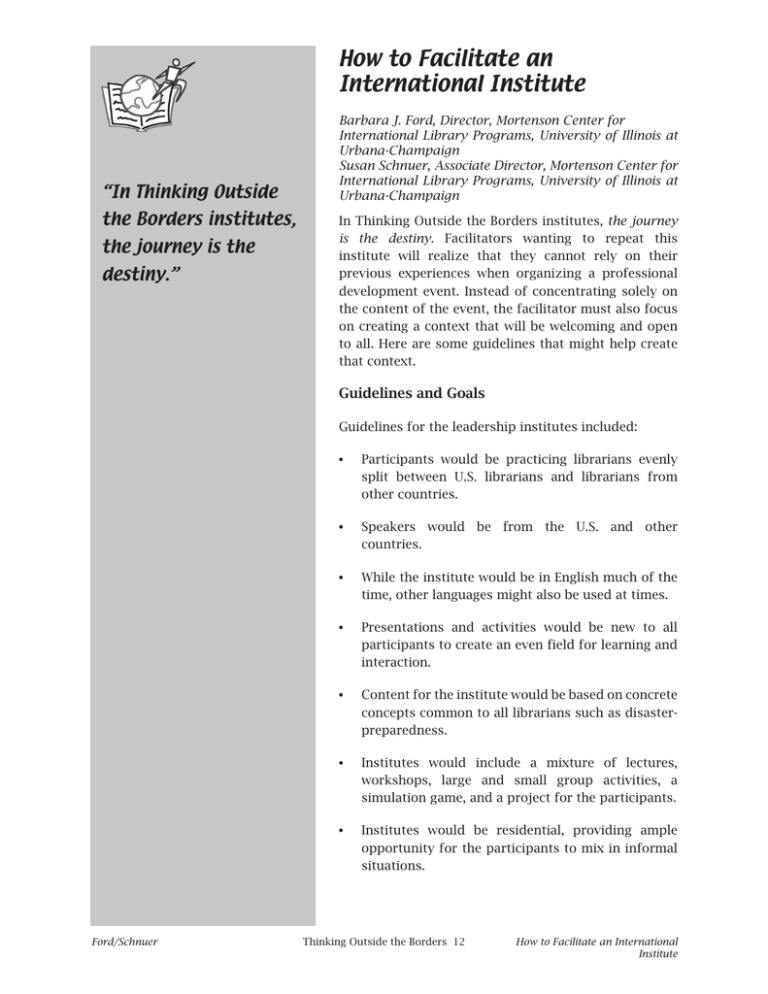
How to Facilitate an International Institute “In Thinking Outside the Borders institutes, the journey is the destiny.” Barbara J. Ford, Director, Mortenson Center for International Library Programs, University of Illinois at Urbana-Champaign Susan Schnuer, Associate Director, Mortenson Center for International Library Programs, University of Illinois at Urbana-Champaign In Thinking Outside the Borders institutes, the journey is the destiny. Facilitators wanting to repeat this institute will realize that they cannot rely on their previous experiences when organizing a professional development event. Instead of concentrating solely on the content of the event, the facilitator must also focus on creating a context that will be welcoming and open to all. Here are some guidelines that might help create that context. Guidelines and Goals Guidelines for the leadership institutes included: Ford/Schnuer • Participants would be practicing librarians evenly split between U.S. librarians and librarians from other countries. • Speakers would be from the U.S. and other countries. • While the institute would be in English much of the time, other languages might also be used at times. • Presentations and activities would be new to all participants to create an even field for learning and interaction. • Content for the institute would be based on concrete concepts common to all librarians such as disasterpreparedness. • Institutes would include a mixture of lectures, workshops, large and small group activities, a simulation game, and a project for the participants. • Institutes would be residential, providing ample opportunity for the participants to mix in informal situations. Thinking Outside the Borders 12 How to Facilitate an International Institute • Development of the context of the institutes would take place in collaboration with the international partners of the Mortenson Center. Leadership institute goals included: • Establish common language for talking about leadership and better understanding of leadership traits in a global context. • Develop cross-cultural communication strategies. • Gain deeper appreciation and understanding of the context of library operations in various countries. • Build lasting professional relationships with librarians from different countries. Content and Organization Having determined the guidelines and goals, the content of the institute was defined. It included advocacy, cross-cultural communication, and negotiation as skills needed by librarians today. Disaster preparedness was added since these issues pose potential, reallife problems for most libraries and most librarians have little training on these issues. The topics were introduced in a tabletop exercise that mimicked a library disaster where participants could apply their cross-cultural communication and leadership skills in an emergency situation. A variety of modules were developed to accomplish these goals and other authors in this publication describe some of the modules that they developed and presented for the institutes. The institutes involved librarians in a dynamic and cross-cultural discussion of common challenges and opportunities and focused on leadership in an international context. U.S. librarians developed an understanding of the impact of global issues on their local context and were encouraged to reexamine current services and collections in light of multicultural and global trends. The leadership institutes took place over several days with participants staying in a local hotel. A typical schedule was: Day 1 Reception – Welcome and Greeting Administration of Leadership Assessment Tool Day 2 Introduction of Partnership Projects What It Means to Lead in the International Library World Strategies and Skills for Cross-Cultural Communication Leadership Assessment Tool – Analysis and Discussion A Cultural Simulation Game Ford/Schnuer Thinking Outside the Borders 13 How to Facilitate an International Institute Day 3 Library Advocacy Diversity and Multiculturalism in Libraries Day 4 Disaster Preparedness or Technology Presentation of Partnership Projects This publication includes examples of modules used for the institutes supported by the grant. A number of institute presenters have written chapters to share what we learned and give ideas for others who may want to set up an institute. The leadership assessment tool we used was the Campbell Leadership Description which we selected after reviewing a number of tools since it is relatively easy to administer and includes a trait called ‘multicultural awareness’ that measured the following skills: has a global view; is culturally sensitive; is globally innovative; provides an effective global leadership image; and is internationally resilient. Mary Ann Mavrinac provides details on the tool and its use. Partnership projects were developed to broaden the impact of the institutes and Dawn Cassady gives information on how these were developed. What it means to lead in an international world was presented in a different way at each institute. Carol Brey-Casiano, Clara Budnik S., and Ujala Satgoor provide excellent inspirational examples of responses to this important question. Strategies and skills for cross-cultural communication were addressed with a variety of approaches by Kathryn Deiss and Sandra Ríos Balderrama and Ujala Satgoor. Cultural simulation games gave institute participants the opportunity to interact and learn in different ways. Pamoja, discussed by Susan Schnuer, and World Café, discussed by Sandra Ríos Balderrama, were two tools that worked well for the institutes. Carol Brey-Casiano was a presenter on library advocacy and her presentation is one approach that can be taken to raise awareness about this important topic. Diversity and multiculturalism in libraries was a theme throughout the institutes. Elizabeth Pierre-Louis and Sandra Ríos Balderrama and Ujala Satgoor address these important topics in interesting and useful ways. Alyce Scott’s workshops on digitization were a highpoint of the institutes for the international librarians who participated. Michael Sauers’ library 2.0 presentation at one of the institutes was very well received and a practical module that could be used by all participants. Disaster Preparedness was a concrete useful module with a table top exercise prepared by Thomas Clareson, Julie Page, and Thomas Teper. Debra Wilcox-Johnson evaluated and assessed the project and provided useful feedback as the institutes were modified based on lessons learned. The leadership training modules developed in the grant were planned to be flexible, so that an entity adapting the program could select the topics it found relevant for its situation and provide training programs of varied duration. The curriculum utilized a variety of teaching strategies including simulation games, leadership assessment tools, lectures followed by group discussions, and case studies. The institutes offered a diversity of presenters in terms of style, presentation, and teaching methods in order to embrace various learning styles. In short we used diversity to reach diverse audiences. Ford/Schnuer Thinking Outside the Borders 14 How to Facilitate an International Institute Among the outcomes expected were learning cross-cultural communication strategies. Participants gained a deeper appreciation and understanding of the context of library operations in other countries and they came to understand some of the implications of international library standards and policies. Most importantly they developed some problem-solving skills useful in international situations. As always happens in these kinds of programs, lasting relationships with librarians from different countries were developed and have led to additional collaborations and learning. Develop Your Own Library Leadership Institute Building trust and discussing leadership in various cultural contexts was an important part of the institutes and assessment tools were helpful in this. While there are universalities in how we look at leadership there are differing cultural and national perspectives on what the words “leader” and “leadership” mean. At some of the institutes, sessions were presented in other languages in order to place United States librarians in the situation they do not often experience. Although the institutes occurred in the United States, they were not intended to be a ‘typical’ experience for the participating librarians from the United States. All participants (including the presenters) found themselves outside of their zones of comfort at some point. Joan Clark from the Arizona State Library had this to say about running this institute, “The program exceeded all of my expectations, and my expectations were high. I’ve created and managed many programs for a variety of audiences and this one had to be in the top three of a 25 year career. On top of that, it was fun!” Nebraska Library Commission also offered the institute in the fall of 2007. Laura Johnson, the organizer, commented: “The Nebraska Library Commission brought Thinking Outside the Borders to Nebraska because it delivered an opportunity for international exposure that would have been difficult for many Nebraska librarians to duplicate……The program planning was important, but the logistical planning was far more complicated and timeconsuming. Commission staffers pitched in and helped to a great degree—that was one of the highlights of the experience for me, the way that people pitched in and helped.” Joan Clark also offered some very practical advice on running this institute: ”No one person could have managed all the logistics during the program. Given the compressed two-day schedule, we couldn’t afford to miss a beat. The support and participation of the entire Library Development Division Team was invaluable. I had outlined the program minute-byminute for my colleagues, and each one had specific assignments. Everything came together so well that minor problems (like the unexpected and unexplained big box that arrived for one of the participants) were solved without anyone noticing. We all benefited from participating since everyone contributed something to the program’s success.” Evaluating institutes of this type is not simple. Activities resulting from the institutes include new library advocacy efforts, improved working relationships, use of learning modules presented at the institutes, changes in library practices, development of joint international projects, and expanded networking with international colleagues. It is a challenge to move from awareness to knowledge to experience cross-cultural improvement. Practicing these skills so change is not so jolting and can be better dealt with when working in an international setting is essential. Ford/Schnuer Thinking Outside the Borders 15 How to Facilitate an International Institute A Wonderful Journey At the Mortenson Center for International Library Programs we know that learning never ends. We are very pleased to have been able to offer these institutes with participation from over 200 professionals from more than 20 countries and 10 U.S. states. Our goal here is to provide ideas that you might use to present leadership institutes in your libraries or library associations. While what we did may not be exactly what will work in your setting or country we hope that the materials presented here will give you ideas on how to develop your own leadership institutes. We end with a special thanks to our partners, colleagues, and friends. Strong partnerships are essential to carry out programs like this. Paula Kaufman at the University of Illinois and Jean Wilkins and Anne Craig at the Illinois State Library gave us the administrative support we needed for the projects. Bonnie Matheis and Joe Natale at the Illinois State Library played very important roles in the entire project working with other Illinois State Library staff to make the grant a success. Joan Clark at the Arizona State Library and Laura Johnson at the Nebraska Library Commission organized the institutes in their states with the support of their state librarians and other staff. Sandra Ríos Balderrama pulled together this publication so that others can learn from and build on what we did with the support of the U.S. Institute of Museum and Library Services. Institute presenters, many of whom wrote chapters for this publication, made it all a reality. Long term Mortenson Center partners from South Africa, Haiti, Costa Rica, and Canada contributed their ideas and expertise. The participants shared their enthusiasm and insights with one another and greatly enriched the journey. Note: For further reading: “Developing an International Library Leadership Institute: Thinking Outside the Borders” in Continuing Professional Development: Pathways to Leadership in the Library and Information World, Munchen: K.G. Saur, 2007, p.40-56, with Susan Schnuer and Debra Wilcox Johnson. Ford/Schnuer Thinking Outside the Borders 16 How to Facilitate an International Institute
